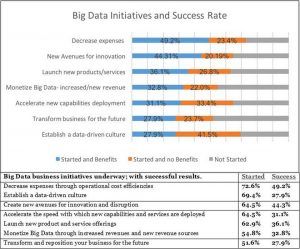The use of big data analytics is vital for consumer product and retail companies to remain competitive. The use of these tools helps to build business strategies that directly affect the bottom line and can transform the way companies conduct business.

SOURCE: NEWVANTAGE VENTURE PARTNERS, BIG DATA EXECUTIVE SURVEY 2017 (PDF, 16 PP.)
Increase Demand and Basket Size of Purchases
Have you ever asked yourself why companies like Amazon, Target, and Walmart recommend goods that are exactly what you are looking for? This is not a coincidence. These companies have developed data analytics strategies that aim to increase the average size of a basket of purchases. The tool that is most commonly used by these companies is Market Basket Analysis (MBA), which is a data-mining tool that seeks to find co-occurring relationships in customers' purchasing behavior and recommend other goods for purchase.
For example, if you are at Chipotle, and you purchase a burrito and tortilla chips, then you are more likely to purchase a drink compared to someone who just purchases tortilla chips. MBA is very effective at increasing the average basket size of purchases by zeroing in on what customers are likely to purchase and recommending those goods.
Increase Customer Retention and Loyalty
In an increasingly competitive market, the ability to retain customers and gain their loyalty can determine whether a business succeeds or fails. Companies are turning to big data analytics to retain the valuable customers they already have by avoiding weak points. Companies can analyze customer experience and behavior, taking advantage of key opportunities to improve customer experience, influence buying behavior, and increase customer retention.
Build Brand Equity
One increasingly popular strategy in building brand equity is social media analytics. Social media provides a way to engage with the consumer in ways that were not possible 10 years ago. To build brand equity, it is critical to be able to measure and assign value to those touch points. For example, people want content that is relevant to them. When people receive content that is relevant to them, they tend to engage the brand more actively, which contributes to the value of that touch point. By increasing the value of touch points, brands can analyze the data and measure what is and is not working. Brands can then assess how best to allocate resources. Through more efficient means of employing resources, brands can gain a competitive edge in building brand equity compared to their competitors.
New Product Innovation
Big data analytics are a critical tool in new product innovation, allowing companies to better meet customer demand and go to market more quickly. Data analytics help companies to align products with customer interests, reduce risk in new product innovation, and properly utilize R&D dollars. Data mining can identify customer needs more effectively, allowing companies to realize an increase in brand value and recognition. Forecasting and predictive analytics can also be used as a tool to more accurately determine the expected revenue before and after the rollout of a product. This helps companies better manage their supply chain and marketing spend to remain competitive.
Determine Optimal Advertising Spend
Advertising spending for consumer product companies, if not handled properly, can burn through cash very quickly, with poor results. This drives up the customer acquisition cost significantly. Through data analytics, you can see the number of visits to your site and determine the cost of every new visit by calculating the total spend per number of visits. You can also track the specific pages on your site that the customer browsed, and the amount of time they spent on each page. Lastly, you can see the value of each transaction, the conversion rate, the revenue generated, and the cost on a transaction-by-transaction basis.
Procurement Optimization
Over the last several years, the quality of data has increased substantially, and as a result, the use of big data analytics has become more effective, and thus vital to the procurement process. One significant challenge with the implementation of big data analytics in the procurement process is the volume of data that procurement teams need to analyze and manage.
While the application of big data analytics to the procurement process presents challenges, there are significant advantages to be achieved around sourcing and contract analysis.
In sourcing, teams can use big data to analyze suppliers' historical performance, prices, and the risk of each contract.
In contract analysis, teams can analyze information embedded in lengthy contracts, such as, terms and conditions, beginning and end dates, hold harmless agreements, and special clauses.
With the right program, companies can search more easily and concisely to find information that drives decision-making as it relates to the business. Procurement optimization through data analytics can help consumer product companies significantly impact their bottom line by avoiding risk, reducing blind spots, and identify the best deals.
The content of this article is intended to provide a general guide to the subject matter. Specialist advice should be sought about your specific circumstances.
